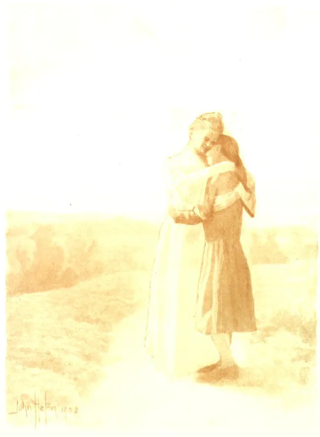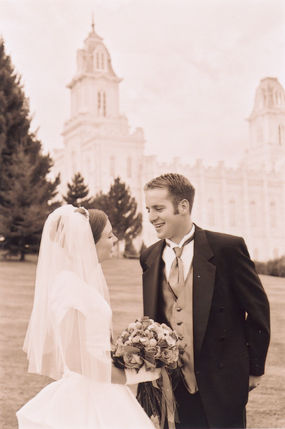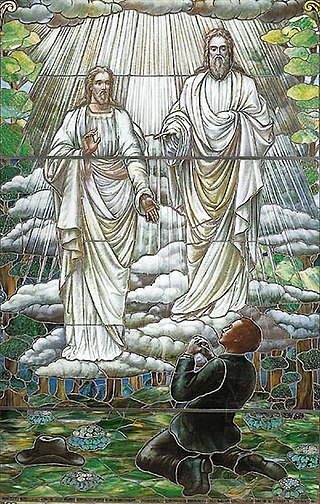Related Research Articles

Mormonism is the religious tradition and theology of the Latter Day Saint movement of Restorationist Christianity started by Joseph Smith in Western New York in the 1820s and 1830s. As a label, Mormonism has been applied to various aspects of the Latter Day Saint movement, although there has been a recent push from the Church of Jesus Christ of Latter-day Saints to distance themselves from this label. A historian, Sydney E. Ahlstrom, wrote in 1982, "One cannot even be sure, whether [Mormonism] is a sect, a mystery cult, a new religion, a church, a people, a nation, or an American subculture; indeed, at different times and places it is all of these."
The Adam–God doctrine was a theological idea taught in mid-19th century Mormonism by Brigham Young, a president of the Church of Jesus Christ of Latter-day Saints. Although the doctrine is rejected by the LDS Church today, it is still an accepted part of the modern theology of some Mormon fundamentalists.

The Book of Abraham is a collection of writings claimed to be from several Egyptian scrolls discovered in the early 19th century during an archeological expedition by Antonio Lebolo. Members of the Church of Jesus Christ of Latter-day Saints purchased the scrolls from a traveling mummy exhibition on July 3, 1835, to be translated into English by Joseph Smith. According to Smith, the book was "a translation of some ancient records... purporting to be the writings of Abraham, while he was in Egypt, called the Book of Abraham, written by his own hand, upon papyrus". Smith said the papyri described Abraham's early life, his travels to Canaan and Egypt, and his vision of the cosmos and its creation.
In the Latter Day Saint movement, priesthood is the power and authority of God given to man, including the authority to perform ordinances and to act as a leader in the church. A group of priesthood holders is referred to as a quorum.

In the Latter Day Saint movement, Goddess the Heavenly Mother, also known as Elah the Mother in Heaven, is the mother of human spirits and the wife of God the Father. Collectively Heavenly Mother and Father are called Heavenly Parents. Those who accept the Mother in Heaven doctrine trace its origins to Joseph Smith, founder of the Latter Day Saint movement. The doctrine became more widely known after Smith's death in 1844.
In orthodox Mormonism, the term God generally refers to the biblical God the Father, whom Latter Day Saints also refer to as Elohim or Heavenly Father, and the term Godhead refers to a council of three distinct divine persons consisting of God the Father, Jesus Christ, and the Holy Ghost. However, in Latter Day Saint theology the term God may also refer to, in some contexts, the Godhead as a whole or to each member individually. Latter Day Saints believe that the Father, Son and Holy Ghost are three distinct beings, and that the Father and Jesus have perfected, glorified, physical bodies, while the Holy Ghost is a spirit without a physical body. Latter Day Saints also believe that there are other gods and goddesses outside the Godhead, such as a Heavenly Mother—who is the wife of God the Father—and that faithful Latter-day Saints may attain godhood in the afterlife. The term Heavenly Parents is used to refer collectively to the divine partnership of Heavenly Father and a Heavenly Mother. Joseph Smith taught that God was once a man on another planet before being exalted to Godhood.
Agency, in the theology of the Church of Jesus Christ of Latter-day Saints, is "the privilege of choice which was introduced by God the Eternal Father to all of his spirit children in the premortal state". Mortal life is viewed as a test of faith, where our choices are central to the plan of salvation in Latter-day Saint teaching. "It was essential for their eternal progression that they be subjected to the influences of both good and evil". LDS Church members believe that Lucifer rebelled against the God's plan, which resulted in a war in heaven, and Lucifer being cast out of heaven and becoming Satan.
The Book of Moses, dictated by Joseph Smith, is part of the scriptural canon for some denominations in the Latter Day Saint movement. The book begins with the "Visions of Moses", a prologue to the story of the creation and the fall of man, and continues with material corresponding to the Joseph Smith Translation of the Bible's (JST) first six chapters of the Book of Genesis, interrupted by two chapters of "extracts from the prophecy of Enoch".
Lineal succession was a doctrine of the Latter Day Saint movement, whereby certain key church positions were held by right of lineal inheritance. Though lineal succession is now largely abandoned, the offices connected with the practice were the President of the Church and the Presiding Patriarch.

Celestial marriage is a doctrine that marriage can last forever in heaven. This is a unique teaching of the Church of Jesus Christ of Latter-day Saints or Mormonism, and branches of Mormon fundamentalism.
The Church of Jesus Christ of Latter-day Saints teaches that Adam and Eve were the first man and the first woman to live on the earth and that their fall was an essential step in the plan of salvation. Adam in particular is a central figure in Mormon cosmology. Robert L. Millet, a Latter-day Saint author, wrote of the church's perspective:
Few persons in all eternity have been more directly involved in the plan of salvation—the creation, the fall, and the ultimate redemption of the children of God—than the man Adam. His ministry among the sons and daughters of earth stretches from the distant past of premortality to the distant future of resurrection, judgment, and beyond.

Mormon cosmology is the description of the history, evolution, and destiny of the physical and metaphysical universe according to Mormonism, which includes the doctrines taught by leaders and theologians of the Church of Jesus Christ of Latter-day Saints, Mormon fundamentalism, the Restoration Church of Jesus Christ, and other Brighamite denominations within the Latter Day Saint movement. Mormon cosmology draws from Biblical cosmology, but has many unique elements provided by movement founder Joseph Smith. These views are not generally shared by adherents of other Latter Day Saint movement denominations who do not self-identify as "Mormons", such as the Community of Christ.
The Church of Jesus Christ of Latter-day Saints takes no official position on whether or not biological evolution has occurred, nor on the validity of the modern evolutionary synthesis as a scientific theory. In the twentieth century, the First Presidency of the LDS Church published doctrinal statements on the origin of man and creation. In addition, individual leaders of the church have expressed a variety of personal opinions on evolution, many of which have affected the beliefs and perceptions of Latter-day Saints.

The Church of Jesus Christ of Latter-day Saints focuses its doctrine and teaching on Jesus Christ; that he was the Son of God, born of Mary, lived a perfect life, performed miracles, bled from every pore in the Garden of Gethsemane, died on the cross, rose on the third day, appeared again to his disciples, and now resides, authoritatively, on the right hand side of God. In brief, some beliefs are in common with Catholics, Orthodox and Protestant traditions. However, teachings of the LDS Church differ significantly in other ways and encompass a broad set of doctrines, so that the above-mentioned denominations usually place the LDS Church outside the bounds of orthodox Christian teaching as summarized in the Nicene Creed.
From 1852 to 1978, temple and priesthood policies in the Church of Jesus Christ of Latter-day Saints prohibited women and men of Black African descent from temple ordinances and ordination in the all-male priesthood. In 1978, the church's highest governing body, the First Presidency, declared in the statement "Official Declaration 2" that the restriction had been lifted. Between 1830 and 1852, a few black men had been ordained to the Mormon priesthood in the Latter Day Saint movement under Joseph Smith.
Exaltation is a belief in Mormonism that after death some people will reach the highest level of salvation in the celestial kingdom and eternally live in God's presence, continue as families, become gods, create worlds, and make spirit children over whom they will govern. In the largest Mormon denomination, the Church of Jesus Christ of Latter-day Saints, top leaders have taught God wants exaltation for all humankind and that humans are "gods in embryo". A verse in the LDS Church's canonized scripture states that those who are exalted will become gods, and a 1925 statement from the church's highest governing body said that "All men and women are in the similitude of the universal Father and Mother ... [and are] capable, by experience through ages and aeons, of evolving into a God."
The concept of premortal life in the Latter Day Saint movement is an early and fundamental doctrine which states that all people existed as spirit bodies before coming to Earth and receiving a mortal body. In Mormonism's eponymous text, the Book of Mormon, published in 1830, the premortal spirit of Jesus Christ appears in human form and explains that individuals were created in the beginning in the image of Christ. In 1833, early in the Latter Day Saint movement, its founder Joseph Smith taught that human souls are co-eternal with God the Father just as Jesus is co-eternal with God the Father, "Man was also in the beginning with God. Intelligence, or the light of truth, was not created or made, neither indeed can be."
References
- ↑ "Gospel Topics: Foreordination", churchofjesuschrist.org, LDS Church
- ↑ McConkie, Bruce R. (May 1974). "God Foreordains His Prophets and His People". Ensign.
- ↑ "Attention and Reflection, Etc., by Brigham Young (Journal of Discourses 6:93-101)".
- ↑ ""Thou Wast Chosen Before Thou Wast Born" Abraham 3; Moses 4:1-4 | the Interpreter Foundation". 4 July 2013.
- ↑ The Church of Jesus Christ of Latter-day Saints
- ↑ 1 Peter 1:19–21
- ↑ Jeremiah 1:5
- ↑ "War in Heaven". churchofjesuschrist.org.
- ↑ Abraham 3:18-19
- 1 2 3 Brent L. Top (1992). Encyclopedia of Mormonism.
- ↑ Terryl Givens (2010). When Souls Had Wings: Pre-Mortal Existence in Western Thought. ISBN 978-0-19-531390-1.
- ↑ Doctrine and Covenants 138:53-56
- ↑ Douglas James Davies (2000). The Mormon culture of salvation: force, grace, and glory. p. 98. ISBN 978-0-7546-1328-2.
- ↑ Terryl L. Givens; Reid L. Neilson (12 August 2014). The Columbia Sourcebook of Mormons in the United States. pp. 40–41. ISBN 978-0-231-14942-6.
- ↑ Ezra Taft Bensen (1977). "A Message to the Rising Generation".
- ↑ Ezra Taft Benson (1986). "To the Young Women of the Church".
- ↑ Ezra Taft Benson (1986). "To the "Youth of the Noble Birthright"".
- 1 2 3 Brent D. Fillmore (2007). "Promoting Peculiarity—Different Editions of For the Strength of Youth". Vol. 8, no. 3. Religious Educator. pp. 75–88.
- ↑ Thomas S. Monson (1990). "That We May Touch Heaven".
- ↑ Elaine S. Dalton (2004). "We Did This for You".
- ↑ Alma, 13:1–9
- ↑ A. Keith Thompson (2016). "Were We Foreordained to the Priesthood, or Was the Standard of Worthiness Foreordained? Alma 13 Reconsidered". Interpreter: A Journal of Mormon Scripture. 21: 249–274.
- ↑ Abraham 3:23
- ↑ True to the Faith. 2004. pp. 69–70.